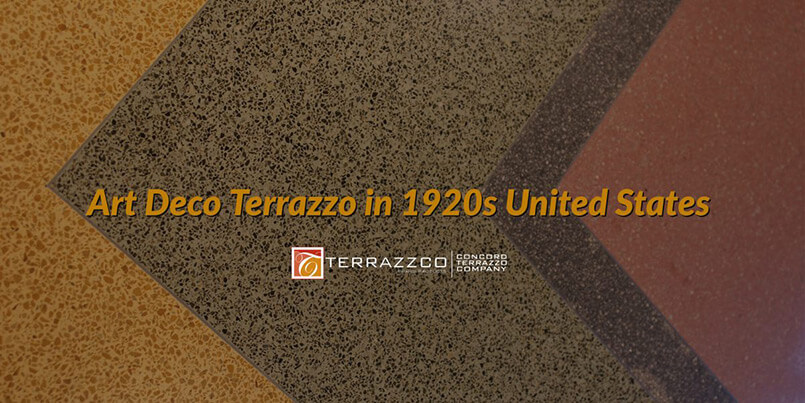17 Sep Art Deco Terrazzo in 1920s United States

Art Deco Terrazzo in 1920s United States
The history of terrazzo dates back well over 500 years ago. Terrazzo, an Italian word meaning terrace, was created by Venetian marble workers during the 15th century. We can define terrazzo as a composite material that is mainly used as a flooring system that mixes together construction aggregates with a cement or epoxy binder. This material is spread evenly across a substrate and ground and polished to produce a uniform surface that is known for its durability, low maintenance, and design capabilities. While terrazzo originates from Italy, it was introduced in the United States in the late 1890s gaining popularity during the Art Deco Movement of the 1920s.
Terrazzo Introduced in the United States
The craftsmanship of terrazzo has been passed down from generations of Italian families. When Italian families immigrated to the United States during the late 1890s, they brought the trade with them. The United States had a wealth of marble thus creating an opportunity for terrazzo to flourish at the turn of the century. The workers were known as terazzeri and were true artisans creating something special with American floors. But terrazzo gained more recognition during the 1920s as Art Deco styles rose in popularity.
Art Deco during the Roaring 20s
By the 1920s, The United States had experienced the aftermath of World War I. More people began moving into cities from the countryside. During this time, the Art Deco Movement arose with a large influence on architecture, art, and fashion.
To best describe Art Deco, it is a design style focused on the use of man-made materials to create sleek geometric or stylized forms. This style was associated with an elegance that promoted wealth and sophistication. In many Art Deco designs, you will notice the use of simplistic and clean shapes. This is perfect for terrazzo as Art Deco designs featured stylized foliage, fragmented suns, zig-zags, and the occasional animal display.
Among the most notable Art Deco monuments include the Chrysler Building and Empire State Building in New York and the Art Deco historic district in South Beach Miami Florida. The style subdued at the beginning of World War II but has left its mark across many industries and helped terrazzo gain favor among architects in the 1920s.
Evolution of Terrazzo in the 1920s
The popularity of terrazzo in the United States rose during the Art Deco movements of the 1920s. In fact, terrazzo experience quite a number of changes during this period.
Among the changes included the invention of the divider strip and electric grinder, introduction of Portland cement, and establishment of the National Terrazzo and Mosaic Association.
Electric Grinder
The invention of the electric grinder in 1924 contributed to the spread of terrazzo in the United States. Before using the electric grinder, terrazzo installers used a long handle known as Galera to polish the surface. The new advancement in technology covered surfaces at greater speeds for a smoother finish. As a result, installations reduced the time and cost to finish a terrazzo project making it a cost-effective finish for buildings.
Divider Strips
Brass Divider strips were introduced during this time as well, useful in preventing cracks from forming in a terrazzo floor. Soon after installers found ways to create intricate patterns and designs in terrazzo. Divider strips were used to separate areas for color changes.
Because terrazzo had the design capabilities of creating straight or curved forms with their divider strips, the material became favorable during the Art Deco styles of the 1920s. As a result, the number of terrazzo installers grew as well.
Portland Cement
Portland cement was introduced to the terrazzo industry thereafter. Portland cement could be dyed with different color pigments which expanded the design possibilities for a terrazzo floor.
National Terrazzo and Mosaic Association
During the 1920s, terrazzo and mosaic contractors formed the National Terrazzo and Mosaic Contractors Association known today as the NTMA (National Terrazzo and Mosaic Association). For nearly 100 years, the NTMA sets standards and best practices for installing terrazzo. Each year, they host technical seminars to share knowledge, examine trends and learn new techniques, and annual conventions that award contractors for their craftsmanship.
Terrazzo saw its breakthrough in the United States during the 1920s, but what is most fascinating is that the terrazzo that was installed during the Art Deco era still last today. This period displays some of the most beautiful terrazzo designs ever made.
Terrazzo continues to evolve over the years. Its gained renewed interest in recent times for its impact on green construction projects through the use of recycled materials and zero VOCs. When the Italians brought terrazzo to America, they brought over a flooring system that earned its reputation as a durable, beautifully aesthetic and low maintenance surface. Other flooring systems can’t match the design and performance of a terrazzo floor. Today you can find terrazzo in locations like universities, government halls, airports, and hotels.






